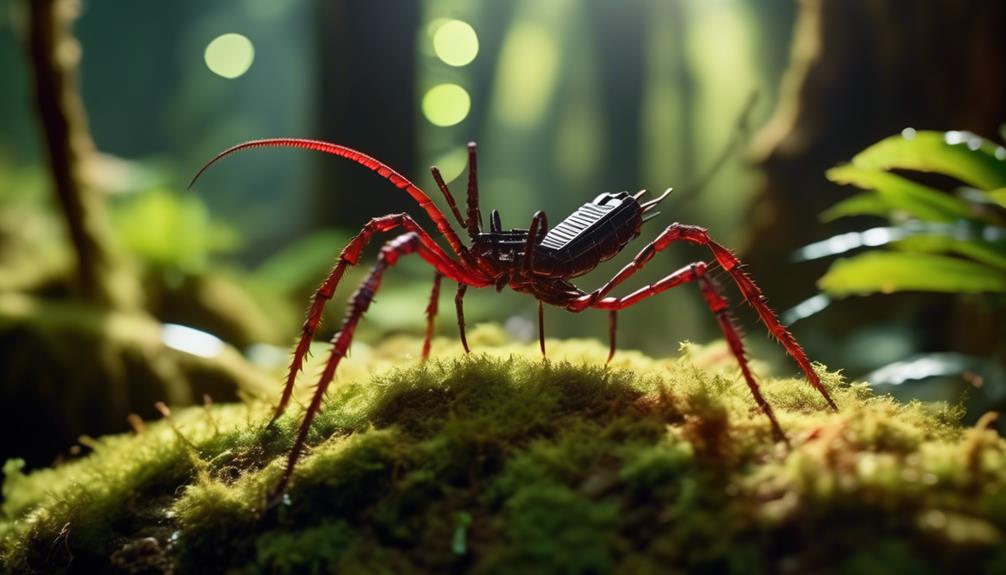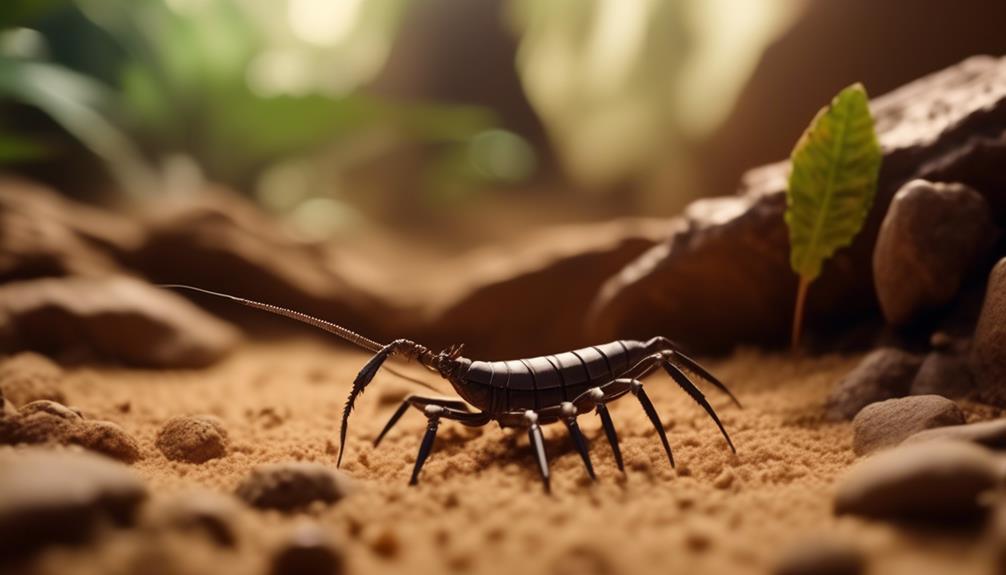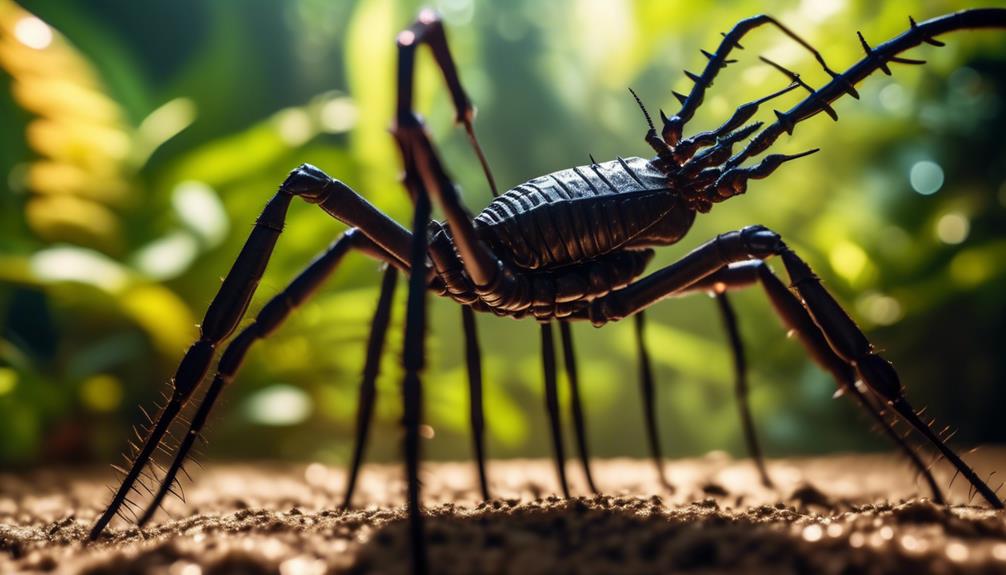Are you ready to embark on an enthralling exploration into the enigmatic world of tailless whip scorpions? Prepare to be intrigued as we unravel the secrets of these captivating creatures.
From their fascinating behaviors to their unique adaptations, there is so much to discover. But what sets them apart from their arachnid relatives?
Join us as we uncover the mysteries that lie within the realm of tailless whip scorpions and shed light on their hidden secrets.
So, are you ready to unlock the secrets that these extraordinary creatures hold? Let's dive in and uncover the wonders that await us.
Key Takeaways
- Tailless whip scorpions require an enclosure that is twice the size of their expected adult leg span, with a secure mesh top for ventilation and molting assistance.
- Lighting for tailless whip scorpions should provide a day/night cycle for natural lighting, with 6500K lighting for live plants. They do not require UVB lighting.
- Temperature requirements for tailless whip scorpions range from 65-77°F for tropical species, with access to a warmer basking area for semi-arid species. A digital probe thermometer and low-wattage heat bulb can be used to regulate temperatures.
- Tailless whip scorpions prefer high humidity levels of 70-90%, while semi-arid species can tolerate lower humidity of 65-75%. Regular misting and maintaining moist substrate help maintain humidity levels.
Enclosure Requirements

When setting up the enclosure for tailless whip scorpions, it's crucial to ensure that the dimensions of the enclosure are at least twice the expected adult leg span in length, width, and height. This provides enough space for the scorpions to move around comfortably and exhibit natural behaviors.
Additionally, the enclosure should have proper ventilation options to maintain air quality and prevent the buildup of moisture. A mesh top is recommended to allow air circulation and assist with molting, a crucial process for the scorpions.
It's important to secure the enclosure well to prevent any potential escapes. Furthermore, if housing multiple tailless whip scorpions together, the enclosure size should be increased to accommodate their needs.
Lighting for Tailless Whip Scorpions
Moving on to the topic of lighting, tailless whip scorpions have specific requirements that must be met to ensure their well-being and natural behaviors are supported.
Tailless whip scorpions don't require UVB lighting, but they do benefit from a day/night cycle that mimics natural lighting conditions. It's recommended to provide 6500K lighting for live plants within the enclosure, as they require this specific spectrum for growth.
The lights should be on for 12 hours a day to simulate a natural photoperiod. However, it's important to provide plenty of shade within the enclosure to allow the tailless whip scorpions to hide during the day.
Temperature Requirements

Tailless whip scorpions have specific temperature requirements that must be met to ensure their optimal health and well-being. Temperature regulation is crucial for these creatures, as it affects their metabolism, digestion, and overall activity levels.
The optimal ambient temperature for tropical species is between 65-77°F. However, semi-arid species appreciate access to a warmer basking area within their enclosure. To achieve this, a low-wattage heat bulb can be used to provide supplementary heat. It's important to place the heat lamp on the side of the enclosure, rather than on top of the mesh, to prevent burns.
Monitoring the temperature using a digital probe thermometer is recommended to ensure the ideal conditions are maintained. By providing suitable basking areas and regulating the temperature, tailless whip scorpions can thrive in their enclosure.
Humidity Levels
Maintaining the appropriate humidity levels is crucial for the health and well-being of tailless whip scorpions. These unique arachnids require specific humidity conditions to thrive and prevent complications such as respiratory issues and mold growth.
Here are three key factors to consider when controlling humidity for tailless whip scorpions:
- Moist Substrate: Providing a moist substrate is essential for maintaining humidity levels. Choose moisture-friendly substrates like Zoo Med Eco Earth or Exo Terra Plantation Soil and ensure a depth of at least 2 inches. Regularly mist the enclosure to keep the substrate adequately moist, but avoid making it swampy or soaked.
- Regular Mistings: To maintain proper humidity levels, spray down the enclosure 1-2 times a day. This helps create a humid environment that mimics their natural habitat. However, be cautious not to oversaturate the enclosure, as excessive moisture can lead to mold growth and harm the scorpions.
- Ventilation: While high humidity is important, it's equally crucial to prevent stagnant air and mold growth. Ensure proper ventilation in the enclosure, particularly through a mesh top. This allows for air circulation and reduces the risk of mold formation.
Substrate Options and Enclosure Maintenance

To ensure optimal conditions for tailless whip scorpions, careful consideration must be given to substrate options and the maintenance of their enclosures. The choice of substrate is crucial as it provides the foundation for a bioactive environment that can reduce stress and promote the well-being of these fascinating creatures. Recommended substrates include Zoo Med Eco Earth, Zoo Med ReptiSoil, and Exo Terra Plantation Soil. These moisture-friendly substrates should be used at a depth of at least 2 inches to allow for burrowing and moisture retention. Additionally, incorporating live plants into the enclosure offers numerous benefits. Not only do they provide a more natural and aesthetically pleasing environment, but they also contribute to the overall humidity levels and provide hiding spots for the whip scorpions. Regular maintenance, such as substrate replacement and enclosure cleaning every other month, is essential to ensure a clean and hygienic living space for these creatures. By carefully selecting the right substrate and maintaining the enclosure, whip scorpions can thrive in a bioactive environment that mimics their natural habitat.
| Substrate Options | Enclosure Maintenance |
|---|---|
| Zoo Med Eco Earth | Replace substrate and clean enclosure every other month |
| Zoo Med ReptiSoil | |
| Exo Terra Plantation Soil | |
| Live Plants | |
| Cork Flats | |
| Low Branches |
Frequently Asked Questions
Can Tailless Whip Scorpions Be Handled or Are They Strictly for Observation?
Tailless whip scorpions should be strictly observed rather than handled. They are not suitable as pets due to their delicate nature and potential for stress or harm. It's best to admire them from a distance.
What Is the Lifespan of a Tailless Whip Scorpion?
Tailless whip scorpions have an average lifespan of 3-5 years in captivity. They reproduce through sexual reproduction, with the female laying eggs that hatch into young scorpions.
Do Tailless Whip Scorpions Require a Water Dish in Their Enclosure?
Tailless whip scorpions do not require a water dish in their enclosure. They obtain moisture from their natural habitat, such as condensation on plants or prey. Feeding habits include consuming small insects and other invertebrates.
Can Tailless Whip Scorpions Be Kept With Other Arachnid Species?
Tailless whip scorpions should not be kept with other arachnid species due to potential cohabitation risks. They have specific enclosure requirements, such as temperature, humidity, and substrate, that may not be compatible with other species.
Are Tailless Whip Scorpions Venomous and Is Their Venom Harmful to Humans?
Tailless whip scorpions possess venom, but it is not harmful to humans. The venom effects are mild, causing slight pain and swelling. However, research into their venom has potential medical uses, such as pain relief and antimicrobial properties.
Conclusion
In conclusion, delving into the mysterious world of tailless whip scorpions has been an exhilarating journey.
By uncovering the secrets of enclosure requirements, lighting, temperature, humidity, substrate options, and enclosure maintenance, we've unlocked the wonders of these enigmatic creatures.
Like a hidden treasure waiting to be discovered, tailless whip scorpions captivate with their unique qualities and defy conventional expectations.
Join us on this extraordinary adventure and let these captivating creatures ignite your curiosity and fascination.


